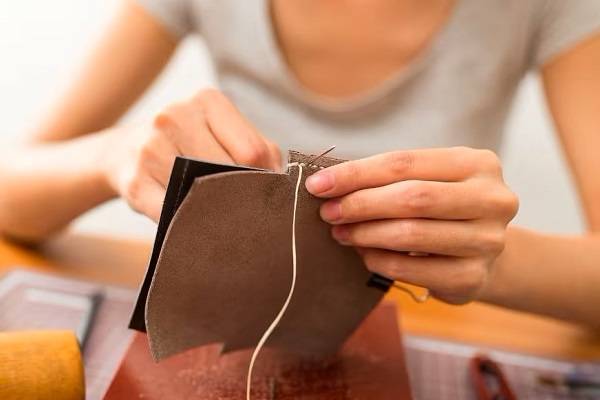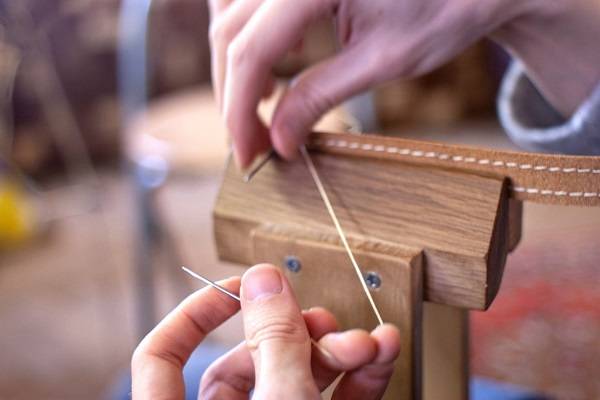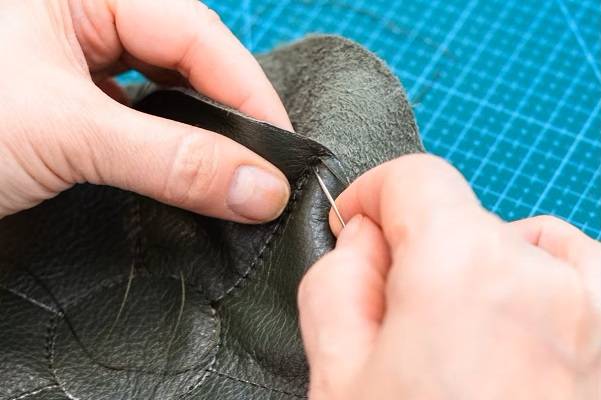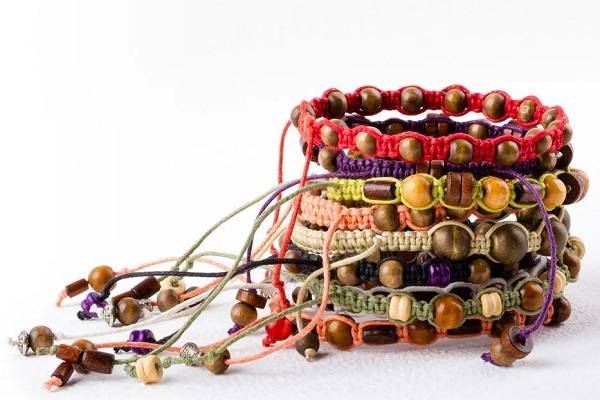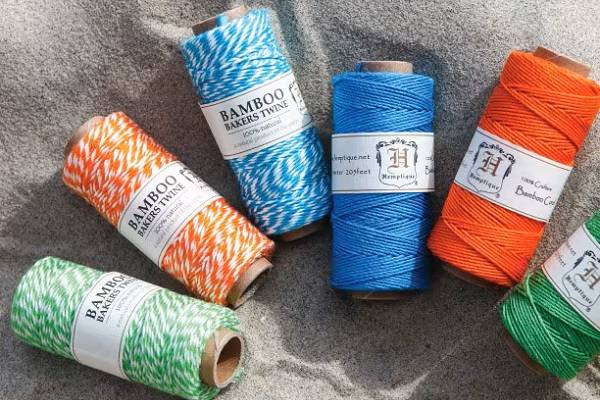How To Choose the Right Thread for Stitching & Sewing Leather
Learn how to pick the right thread material, size, wax and weight to create stunning and long-lasting leather items.

Innovation & Quality
Developing and supplying premium-quality, sustainably grown, consumer products
100% Natural
Organically Grown and Ethically Sourced
hemp and other natural fiber products
Shipping
We offer fast shipping
Your order out within 1-3 days
Wholesale
Visit our wholesale portal to register or login to your account
When it comes to crafting, it’s no surprise that choosing the right supplies can make or break your project. The thread you choose for your leather work can be the difference between a durable piece that looks astonishing and a piece that looks shabby and quickly falls apart.
Leather crafting requires precision and attention to detail. A lot of times, artisans end up unhappy with their end product because their thread choice was not a good fit. To avoid ruining the integrity of your craft, it is important to remember that not every thread can be used for sewing or stitching leather.
In order to be able to pick the most suitable string for your task, it is essential to understand different types of thread and how their characteristics (size, strength, elasticity, sewability, tensile strength, etc.) affect the overall performance and design of the finished product.
In this guide, we will analyze how materials like hemp, linen, and polyester impact the performance, seam quality, item longevity, and aesthetics of the final design. You will also find information on size, weight, and shape, as well as the difference between waxed and non-waxed finish. Using information gathered here you will be able to choose proper leather stitching threads for your next leather DIY project.
Shop High-Quality Leather Sewing Threads at Hemptique. Bulk Orders & Volume Pricing Available.
If you need first-class supplies for your leather crafts and DIY projects, you have come to the right place. Hemptique offers an assortment of premier threads that you can use for making leather items such as bags, pouches, totes, document holders, belts, shoes, or accessories. Browse our web store to find top-quality fibers such as premium linen thread, hemp thread, and polyester thread. Known for their remarkable attributes like durability, strength, color fastness, and longevity, they are offered in several sizes and weights, allowing for versatile applications, ideal for various leather sewing projects. We work with individual buyers, businesses, organizations, distributors, and wholesalers. Call us at (760) 602-4864, ext. 403 and 405, or fill out the form to order in bulk or register for wholesale account.
Which Material to Choose
There are several materials that can be used for leather sewing, including linen, polyester, hemp, and nylon.
Polyester
Poly thread is made from petroleum-based synthetic material by combining thin strands. It can be spun, bonded, filament, corespun, trilobal, or braided. It’s similar to nylon and comes in different weights and sizes. You can use it for hand sewing, machine sewing, and many other applications. Polyester is strong and resistant to fraying and color fading and holds stitches secure even under pressure.
Nylon
Nylon thread, although similar to polyester, is bonded to form a single strand. It offers greater stretch and enhanced wear resistance compared to polyester. It is an excellent choice for sewing leather and it matches perfectly with different thicknesses and weights of the material. It can be used for both machine sewing and hand sewing. It’s very strong and durable, and keeps seams tight.
Hemp
Hemp string is manufactured from the fibers of the hemp plant that are spun or twisted into yarns. Natural fibers are typically not as uniform as artificial materials unless they are waxed. For this reason, it is best to use hemp for making natural, rustic, organic, or rugged looking items.
LINEN
Waxed linen is perfect for traditional hand stitching of leather. Because it has high tensile strength, it is preferred supply for making all kinds of leather goods like card wallets, passport covers, keychains, belts, horse saddles, backpacks, etc. Furthermore, linen is a natural material that fits flawlessly with leather and holds exceptionally well.

Recommended for leather hand stitching: Premium linen thread
Size
Leather thread typically comes in 3 common options - .6mm, .8mm, and 1mm.
Use smaller size fiber for making delicate goods like watch straps or wallets, because thicker thread makes thin leather wrinkle and crease.
The smallest size (.6mm) is best suited for delicate work and thinner materials as it will not overpower leather.
0.8mm size is generally used for crafting shoes, bags, and belts, while 1mm size is typically leveraged for utility purposes.
The size of the thread depends on how thick the material is and the type of stitch you will be using. Opt for thicker and stronger string when making items that will be under a lot of stress, such as luggage, outdoor gear, sports equipment, or handles.
How to Determine the Right Thread Size?
To determine the most appropriate size of the thread, divide leather thickness value (in millimeters) by 7. It should give you a rough idea on suitable thickness.
This means that you should get a 0.45mm or 0.5mm size thread. Remember to take into consideration how thin the material is.
For instance, if you are stitching together two pieces of 1.5mm leather, this is the calculation:
(1.5mm + 1.5mm) : 7 = 0.42

Recommended product: 0.45mm Waxed & bonded round poly thread
Thread Weight
Another vital aspect of achieving durable and neat-looking stitches is thread weight. The weight can substantially influence the durability and the overall appearance of your leather handcrafts. The thicker it is, the more visible the stitches will appear.
Leather thickness
- If you are working with lightweight and thin material, such as lambskin or goatskin, choose light weight thread as well. This way, it will complement the delicate and very soft nature of the leather.
- Heavier and stiffer materials like cow or buffalo hide, require heavier (thicker) thread to ensure enough strength to withstand continuous use. It’s best to use waxed polyester.
Project type
- Use finer thread for small and refined work on leather wallets, cardholders, key fobs, watch straps, and jewelry making.
- If you are crafting large or oversized items like bags, luggage, attaché cases, or trunks, opt for heavier string that can handle a lot of weight and stress.
Item aesthetics
For subtle stitches use thinner thread, and for prominent needlework, use thicker string.

Recommended for leather jewelry making: Polished hemp thread
Why Shape Is Important
The shape of thread is important because it determines the integrity of work as well as the final look of your DIY item.
Round
Round thread looks organic but is susceptible to protruding the leather. Many hobbyists use this shape for round holes.
Flat
A flat thread sits closer to surface, but may not look as appealing since they stretch to fill the hole entirely. Make sure not to twist it while stitching so your stitches are even.
Braided
If your DIY task calls for hand sewing (instead of machine sewing), braided thread can ease the job. It is composed of several fibers which are braided together to offer increased flexibility and strength.

Recommended product: Braided & flat waxed thread
Waxed Threads for Leather
Leather goods typically endure a lot of wear and tear. To enhance longevity and resistance to abrasion, wax coating is applied to threads.
Waxed thread
Wax coating keeps fibers together, adds strength and increases resistance to moisture. Furthermore, it provides smoother stitching, easier threading, and better aesthetics. It’s great choice for hand-sewing leather items like wallets or bags, since it is tough to snag or break.
Non-waxed threads
Unwaxed threads may also be used, however keep in mind that dry fiber does not glide through holes, doesn’t hold it’s shape as well, is less durable, and more susceptible to damages form moisture or mold.

Recommended product: 1.0mm Silky Smooth Waxed Thread
Machine-Sewing vs. Hand-Sewing Thread
You should also take into account whether you plan to hand-sew or machine-sew the item. Some fibers are more suitable for hand-sewing, while others are better for machine sewing.
Use natural fibers (linen, hemp) coated with wax when hand-sewing leather. The wax coating will allow for easier gliding through materials and better overall appearance of your handicraft.
Even though the differences may seem insignificant, it’s essential to familiarize yourself with their characteristics in order to prevent issues down the line. Even the smallest problems can cause low-quality product and less than satisfactory performance.
Polyester and nylon threads are preferred for machine-sewing as they are designed to withstand rapid movements of the machine while remaining resistant to fraying or breaking. Use them to maintain consistency in stitching and neat and polished look.
Final Thoughts
Whether you are a seasoned crafter, an artisan, or simply a beginner, at some point you will have to choose a thread to successfully complete your leather project. Using information in this guide you will be able to pick the right thread for your specific needs. Hemp, linen, or polyester – whichever size or weight you choose you can be confident that your final leather product will last you a very long time.


